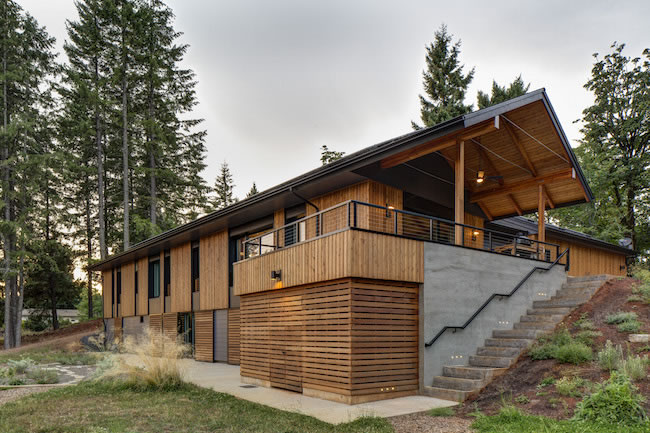When Bryan and Stephanie Farris moved into their custom-build home near Portland, anyone sending housewarming gifts was better off making a personal delivery. Not because sending next-day would be some breach of etiquette, but because the home’s meticulously constructed envelope was so airtight that the Farris family couldn’t hear trucks pulling up in the driveway (they later installed an alarm). If the wind is whipping up outside with 30-mile-per-hour gusts, the interior is still whisper-quiet. One of the few things Stephanie misses in her new home is the sound of raindrops falling outside.
“It’s so airtight it almost makes your ears pop,” Bryan Farris says. “You can kind of feel the pressure change when someone opens the door.”
Consider it the strong, silent type. Known as the Pumpkin Ridge Passive House, the Farris’s 3,600-foot home in North Plains, Oregon, exemplifies the passive house principles of minimizing energy loss and maximizing energy gains. Built with efficient appliances and lighting, triple-glazed windows, and an ultra-tight, 14-inch envelope (standard walls are six inches), it’s insulated, efficient, and stays a constant 71 degrees. To put that into perspective, the home requires 8,000 BTUs for peak heat load—a significant drop from the 90,000 BTUs needed for a standard home. It’s good, then, that the home uses LED lightbulbs, seeing as conventional bulbs would actually put out too much heat.

PROJECT
LOCATION North Plains, OR Program Passive House
Size 3,093 ft2
Completion 2014
Certifications PHIUS+, DOE Zero Energy Ready Home, Earth Advantage Platinum
TEAM
ARCHITECT Scott Edwards Architecture
Builder Hammer & Hand Mechanical Consultant Jonathan Cohen of Imagine Energy
Structural Engineer Carissa Farkas Engineering
CPHC Skylar Swinford, Hammer & Hand
SUPPLIERS
Windows Zola Windows Insulations GreenFiber Insulation, Big Sky Insulations
Wetflash R-Guard System Prosoco
Agean and SIGA Tape Small Planet Workshop
The Farris’s weighed the options and discovered it was roughly 8% more to ditch a standard layout and go with a passive house design with a heat recovery ventilation (HRV) system to circulate air. They estimate they’ll see payback for the added cost of the efficient design within 10–12 years, and that’s before factoring in the savings provided by the solar panels they recently installed, which actually make their residence a net positive home. According to Sam Hagerman, whose firm Hammer & Hand constructed the home, the hybrid system they devised with a heat pump and HRV system turned the ductwork into both a heating and cooling distribution network. Thanks to the magic of passive homes, it resulted in a single utility that handles heating, ventilation, and exhaust, simplifying the entire layout. “We struggle because heating and cooling equipment is too big for our needs but luckily there are now small, efficient heat pumps,” he says.
Built over nine months on a south-facing site nestled into a hillside, Pumpkin Ridge was made to be a “machine for living,” says architect Rick Berry of Scott Edwards Architects, who heavily factored simplicity and clarity of mind into his design of the 80-foot-long building. With solar gain acting as such a key factor for heating, Berry built in a gabled overhang for the upper level and a system of 7-by-6-foot sliding cedar shades that could be dialed-back to control for varying sunlight, an intuitive change as simple as making a swipe on a smartphone.
“I wanted to create a house for families,” says Berry, who designed an elongated structure to create the common space the Farris’ wanted while also allowing every room to take advantage of the view. “The house is a simple rectangle with windows that create a fun, energetic little facade.”
“There’s no sacrifice,” Bryan Farris says of the new home. “The difference is that you put more thought and engineering on the front end of the house, and you just build a smarter house.”
Requiring as little work as possible, the Pumpkin Ridge Home is smart in that it requires minimum effort for maximum comfort. Just check the thermostat. Ironically, since the advanced heating and ventilation system runs relatively incident free, the Farris’s haven’t had to touch it since reading the directions during set up.

The clients behind this project discovered it was roughly 8% more to ditch a standard layout and go with a passive house design with a heat recovery ventilation (HRV) system to circulate air.


